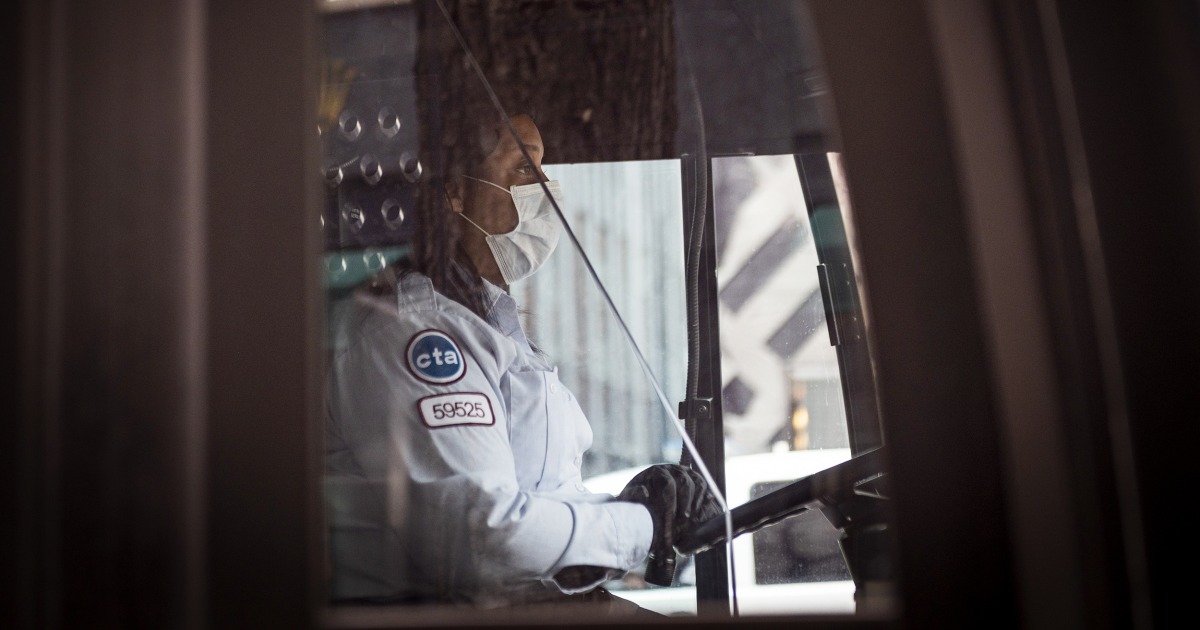
CHICAGO — For more than a year, Chicago Transit Authority bus driver James Clemons’ usually bustling route has been a ghost town.
Clemons’ route through Chicago’s North Side neighborhood takes him past a Mariano’s grocery store. In normal times, the nearby bus stop is filled with shoppers pulling carts of grocery bags onto the bus to take home. But that hasn’t been the case since Covid-19 arrived in the U.S. early last year.
“Nobody was riding the train. Nothing was open. Nobody was going to work, so there was no ridership,” Clemons said while on break near the store. The normally bustling bus stop was empty.
Ridership has started to pick up in the weeks since Chicago fully reopened its economy. But it’s nowhere near pre-pandemic levels, and Clemons isn’t sure when the route will be busy again.
“You can’t look at it in three weeks to say, ‘OK, yeah, they’re going to go back to normal,'” Clemons said, “because they might, they might not.”
Chicago is one of many cities where public transit faces an uncertain recovery. While some aspects are starting to return to normal, new data suggest that mass transit is still struggling to get back on track.
In June, the nationwide ridership of some bus, subway and commuter rail systems was still down by nearly two-thirds from 2019 levels, according to an NBC News analysis of three years of data from the mass transportation scheduling app Transit, which estimates ridership based on use of the app and information from transit agencies. And transportation experts say the numbers might not rebound until the end of the year.
Ridership plummeted early last year, when cities issued stay-at-home orders and companies began allowing remote work. Essential workers and those reliant on public transit commuted on nearly empty trains and endured service cuts and mask mandates.
The number of people using public transportation has increased since then, but it’s still nowhere near what it was. Commuters were estimated to have taken 358 million rides in June, up by 200 million from April 2020, the first full month after stay-at-home orders were implemented to prevent the spread of Covid-19. But that’s still far below the 918 million rides commuters logged in June 2019.
Changing work, life and commuting habits have thrown public transportation’s future into question. The past year has disrupted industries and upended norms, with some companies allowing for permanent remote work. Many urban employees traded cramped apartments for houses in the suburbs.
Some people have changed commuting habits entirely, taking advantage of new options like e-bikes and e-scooters. Others have bought cars, sending used car prices to new highs. Mobility data from Apple show that since last year, car travel has outpaced public transit during the pandemic.
“The impact has been truly unprecedented in terms of the ridership losses and the revenue losses that we’ve seen to the industry,” said Paul Skoutelas, president and CEO of the American Public Transportation Association, a nonprofit organization that lobbies for public transit funding, which partnered with the Transit app to provide its members with analysis of ridership.
Skoutelas said that every transit agency was hit but that he expects ridership to come back eventually.
“Once we get through the summer, back to this September, when kids get back to school and businesses bring their workforces back, we expect that number to continue to rise,” he said.
The Transit app allows users to check real-time information for buses and trains and to schedule ride-sharing, bike-sharing and scooter trips. The company used data from those interactions to estimate actual ridership use.
Transit spokesperson Stephen Miller said in an email that the company statistically modeled ridership based on how frequently users opened the app across the country.
The models give a glimpse into what’s happening with about 130 transit systems, some of which are bouncing back faster than others.
According to the Transit data, trips on the Los Angeles Metro dropped by almost three-quarters in March 2020, falling from 7.5 million trips to 2.2 million in the week of March 22, when a statewide stay-at-home order was issued.
California lifted most Covid restrictions in June. During that month, Transit data estimated 21.3 million trips on the Los Angeles Metro, up from 10.3 million in April 2020. The numbers are still down from June 2019, when it is estimated there were 30.2 million rides.
In New York City, estimated bus and rail ridership for the Metropolitan Transportation Authority increased to 131 million trips last month, more than triple the 37 million trips in April of last year. While it’s a substantial increase, the number is still about half what it was in June 2019.
“We’ve got 48 percent of our ridership back on the train and about 57 percent of our ridership back on the buses,” said Sarah Meyer, chief customer officer for the MTA. “So we’re slowly but surely getting there.”
Ridership for the Washington Metropolitan Area Transit Authority dropped after Mayor Muriel Bowser declared a public health emergency on March 11 of last year. Ridership hit a record low the next month, estimated at 700,000 subway and bus rides. Ridership has bounced back since then — nearly 2 million rides were recorded in the week of June 27, the most since the pandemic began.
Chicago fully reopened its economy last month, and estimates of rides on the CTA were up nearly 87 percent from April 2020. Last month’s rides are still down by more than half since 2019, when 36 million trips were estimated during the same period.
CTA spokesman Brian Steele said that the numbers are well below pre-pandemic ridership but that signs point to workers’ returning to offices in the downtown Loop.
“One of the biggest increases we’ve seen is ridership to and from the Loop,” Steele said. “Since May 1, ridership is up 53 percent on rail lines serving the Loop and 41 percent on bus routes serving the Loop.”
The picture isn’t entirely rosy, as revenue from local governments and fares fell during the pandemic, putting several transit systems in financial jeopardy.
The CTA attributed this year’s $375 million budget shortfall to the pandemic and relied on federal funding to prop up services.
Congress tried to make up for some of the shortfall, providing transit agencies with $25 billion through the CARES Act in March 2020 and following up with $14 billion in December.
Despite the two waves of relief funding, public transit authorities still face a projected shortfall of $39.3 billion through the end of 2023, according to a report from the American Public Transportation Association.
Skoutelas, the group’s president, said that ridership habits are changing and that transit systems are adapting by redesigning routes and adjusting prices.
“People might not be coming to [the office] five days a week,” he said. “They’re looking at prices that’ll be attractive for those coming in two or three days.”
In May, Chicago reduced its summertime one- and multi-day pass prices to boost ridership. On Tuesday, New York’s MTA announced that it will hold off on fare increases this year to lure back riders.
“We’re in this huge transition period [for] agencies and as an industry,” Skoutelas said.
“We really are faced with a lot of innovation that’s taking place in order to position the systems that serve our cities and communities, [to] position them for success going forward,” he said.
Source: | This article originally belongs to Nbcnews.com








